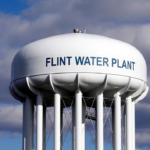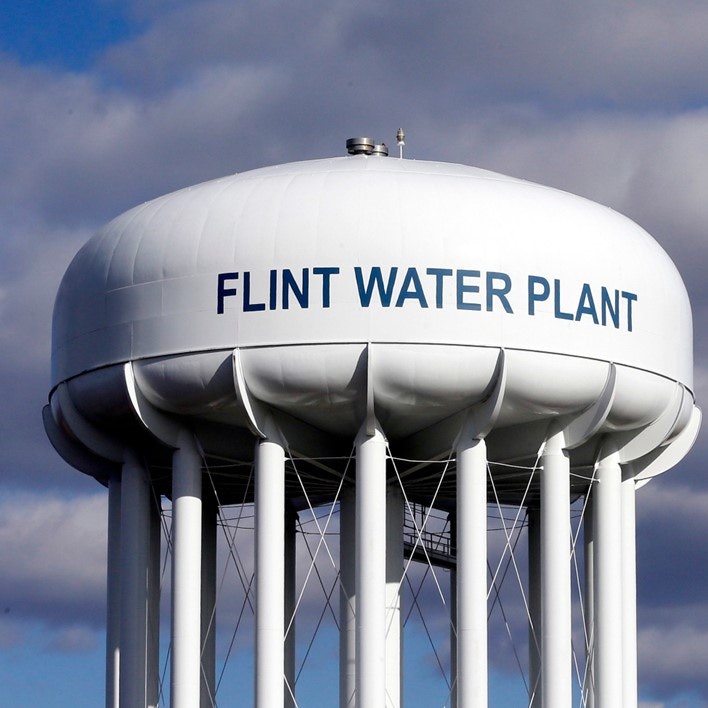When Dr. Benjamin Pauli moved to Flint, Michigan, in June 2015, the town was already one year into a water crisis without knowing it. He was to begin his role as an associate professor of social science at Kettering University in the heart of the city and just feet from the glittering Flint River.
“We heard when we moved into the neighborhood there’d been issues with the water, but we were given the impression it was under control. We weren’t given any indication of a public health threat or a direct threat to our family,” says Pauli. “So, we began using the tap water for drinking and other purposes.”
That tap was being supplied by the Flint River, a change that occurred on April 25, 2014. Traditionally, Flint had received its drinking water through Detroit, which treated and dispensed water from Lake Huron. Now, the water was discolored, murky, often filled with visible debris. While citizens collected this water and reported their concerns, city and state officials shrugged them off. Dr. Benjamin Pauli
Dr. Benjamin Pauli
Through the hard work of activists and researchers, the Flint water crisis came to light. Water from the river was corroding the old pipelines, leaching lead into the drinking water, and emails between government officials, including leaders of the U.S. Environmental Protection Agency (EPA), revealed a massive cover-up.
It wasn’t just lead that was poisoning the citizens of Flint. The water also contained a deadly bacteria known as legionella. Officially, 12 people lost their lives. However, subsequent investigations have revealed that the actual toll is likely much higher, with as many as 78 individuals dying from complications of the disease that presents similarly as pneumonia. Many who survived their bout with the disease still face health complications.
Through 2015 and 2016, volunteers, celebrities, and politicians clambered to the beleaguered city, ushering in national attention, funds, and bottled water. After a lawsuit brought against the city and state, Michigan was required to provide $97 million to remove lead and galvanized steel water lines and develop a comprehensive water monitoring system.
While the majority of the work has been completed, the current construction still requires citizens to opt in and consent to their pipes being changed. As Flint missed deadlines and goals repeatedly, the state of Michigan has agreed since May to step in and continue the work.
Although the source of Flint’s water was returned to Lake Huron and Detroit on Oct. 16, 2015, the damage to people’s trust and health lingered. Now, a decade later, the success of the response in Flint is still questioned. Some experts say that Flint’s water has been clean for years, and its citizens are healthy. Others, including Flint residents, have their doubts.
Mistrust
The city is haunted by the lingering legacy of its lost autonomy and the lies told to its citizens by official sources, leading to the continued mistrust of federal, statewide, and even independent agencies. The question remains whether America has learned its lesson in Flint, particularly as water crises continue to occur in cities across the country. Flint revealed how delicately close impoverished cities are to a potentially deadly infrastructural crisis.
“We have a problem in America, in that each city gets the water they can afford,” says Dr. Marc A. Edwards, a professor of engineering and water resources engineering at Virginia Tech University, and lead investigator that first confirmed the high lead count in Flint’s water. “Short of bankruptcy, there’s no mechanism by which state or federal money can be mobilized to help.”
While Edwards says the EPA and other regulatory agencies have made changes to ensure another Flint doesn’t occur on a bureaucratic level, they have not been able to change the “infrastructure inequality issue.” He adds that hundreds of cities are at risk. Those cities, he says, are “exemplified by the poor, red (Republican-leaning), rural communities, or post-industrial cities that are often blue (Democratic-leaning), where they’ve lost population and they can’t afford to maintain their existing infrastructure, much less improve it.”
In 2014, the city of Flint was one of those “blue” cities facing a financial crisis. The once thriving home of the auto industry had seen its population peak in 1960 at 196,940 citizens. But as auto manufacturing companies moved their factories overseas, the population began to shrink and poverty rates began to climb. By 2011, the city held a $25 million deficit.
 Dr. Matthew Seeger
Dr. Matthew Seeger
Michigan state law allows the governor to put financially unstable cities into a state of emergency management, which is why then-Gov. Rick Snyder appointed Emergency Manager Darnell Earley to oversee the city. Earley essentially became Flint’s mayor and city council, and he decided that the best solution for Flint’s financial crisis was to cut funds where he could.
The water sourced from Detroit cost the city millions — switching to the Flint River, and the city’s unprepared and aging Flint water treatment plant, seemed like an effective way to reduce costs.
Emergency management, and the placement of emergency managers who have not been voted for by the city they govern, is a practice that Pauli called “a very strikingly un-American, autocratic form of governance.”
“I had no idea at that time that there were states in this country that were making use of that form of government, against the will of the governed,” says Pauli. “I was learning about the power states have, to do whatever they like with local units of government, cities included, and I started thinking about the connection more generally between democracy and public health.”
Pauli says a local water and democracy activist named Claire McClinton shared an important lesson with him: “’If we’re the ones making decisions about the water we drink and where it comes from, if we’re the ones making decisions about ourselves — we’re not going to hurt ourselves,’” says Pauli, quoting McClinton. “It’s part of the essence of the democratic ideology, which is that the people have the best understanding of their interests.”
It’s why Pauli titled his book Flint Fights Back: Environmental Justice and Democracy in the Flint Water Crisis. In it, he details the struggle for a working democracy, noting that the systems in place in Flint, including a city council and activists, fell short of the “outcomes that people expected of it.”
But Pauli also acknowledges that the funding needed to address the aging infrastructure of Flint far surpassed what its local democracy, and local democracies of other impoverished cities, could undertake.
“A lot of these cities can’t take out the loans you would need to make that stuff [like pipe replacement] happen. They’re not in good enough standing, credit-wise, and if you don’t have government support in the form of low or no-interest loans, a lot of this stuff isn’t going to happen,” says Pauli. “If you look at other communities like Flint, there’s a history of underinvestment, a majority minority population that don’t have a lot of political power or economic resources — that’s the kindling that in theory, at any time, could become a fire. It just takes one instigating event to send everything into a downward spiral.”
Shocking results
Edwards was first drawn into the story in 2015, when his friend Miguel Del Toral, who was then Region 5 Regulations Manager at the EPA, sent an email alerting him to the water crisis at hand, very similar to one Edwards had worked on in D.C. In 2004, two-thirds of homes in the D.C. area tested positive for lead levels above the EPA threshold due to corroded pipes.
Edwards says he waited to see if the EPA would take action and “do their job,” but as that hope failed to materialize, Edwards says he and his team “knew the system had failed. We had to mobilize, so we did.”
He brought his team from Virginia Tech to Flint, where they would eventually confirm two important truths through testing the water and issuing Freedom of Information Act (FOIA) requests to federal agencies. Lead was, in fact, present at dangerous levels in the drinking water of Flint, and the EPA and state governments failed to inform Flint’s citizens of the risks.
Dr. Matthew Seeger, a professor of communication and an adjunct faculty member in the School of Medicine at Wayne State University in nearby Detroit, specializes in emergency communications. When he first heard about the water crisis, he assembled an interdisciplinary research team including engineers, political scientists, sociologists, and public health experts.
“Flint is a sister city [to Detroit] — we’re older, industrial cities with a legacy of the auto industry, minority and immigrant populations, and communities that have underlying health disparities. We had a very good capacity to understand the people of Flint and what was going on with them, how they were experiencing this,” says Seeger.
His team not only found an association between the change in water source to the outbreak of Legionnaire’s disease, but also examined the failures in communication that ultimately led to the dangers being kept from citizens.
“It was an emotionally laden time,” he continues. “And people were really, really angry, and very, very frustrated. They felt they had been lied to, misled, and, in some cases, they felt they were treated as lab rats. It was a very emotionally charged set of circumstances.”
Seeger says his research uncovered poor coordination between the various agencies set to monitor and safeguard the city’s water supply. Often, Seeger says, miscommunication errors can be rooted to a common human behavior: denial.
“We’re profoundly incapable of making sense of signals or data that indicate things aren’t operating in a good way and lead to disaster. Based on the FOIAs, all the emails regarding the water crisis that were released, we investigated to see how people were communicating, what they were saying about the crisis to identify where there were fundamental breakdowns in the ability to understand it was a significant problem that needed attention,” says Seeger. “[Flint] can be understood as a political failure, an engineering failure, and a public health failure. From my perspective, it’s a failure of communication and warning systems and the ability of individuals to make sense, receive, and interpret messages about what was going on.”
Seeger says that these obvious signs of trouble may have been disregarded for several reasons. One, leadership was overwhelmed coordinating the management in Flint and Detroit, which was also being run by an emergency manager at the time. Two, Snyder was a Republican governor and Flint a Democratic city, and tensions between the two may have interfered with proper communication, says Seeger.
The crisis has taken an emotional and psychological toll on the citizens of Flint, who Edwards says now have access to safe drinking water. Shortly after doctors found increased blood lead levels in children in Flint, the public school system saw an increase in students who needed special education. But Edwards’s research shows the increase likely correlates to a “nocebo” effect, where a patient (or, in this case, the population of Flint) has negative expectations about a treatment. The research concludes that, despite neuropsychological assessments diagnosing lead poisoning or brain damage in the children tested, it did not correlate to actually elevated blood lead levels. In fact, a majority of those children had prior learning disability diagnoses.
“It’s a sad story, from beginning to end,” says Edwards. “At one point, the pendulum was so skewed you could barely get attention on lead in drinking water and the elevated blood lead in kids and within a few months, it went to this other extreme where equally damaging lies were occurring about harm that didn’t occur.”
Pauli, who still lives in Flint, says he and his family do drink the tap water, with the support of water filters under the sink and in the refrigerator. Flint’s water has successfully passed its federal lead and copper level tests since July 2016, and in 2024, lead levels show signs of dropping even farther. But Pauli acknowledges that many citizens of Flint still rely on bottled water.
“At the end of the day, so much of this comes down to trust, making your best guess about whether or not your water is safe,” says Pauli. “The water industry is saying this all the time. They basically believe the tap water is fine, and people should just use it. And I understand where they’re coming from, but especially in a city like Flint, you tend to think about it a lot. You’ll never know with perfect certainty if our water is safe.”
#Decade #Flint #Water #Crisis










